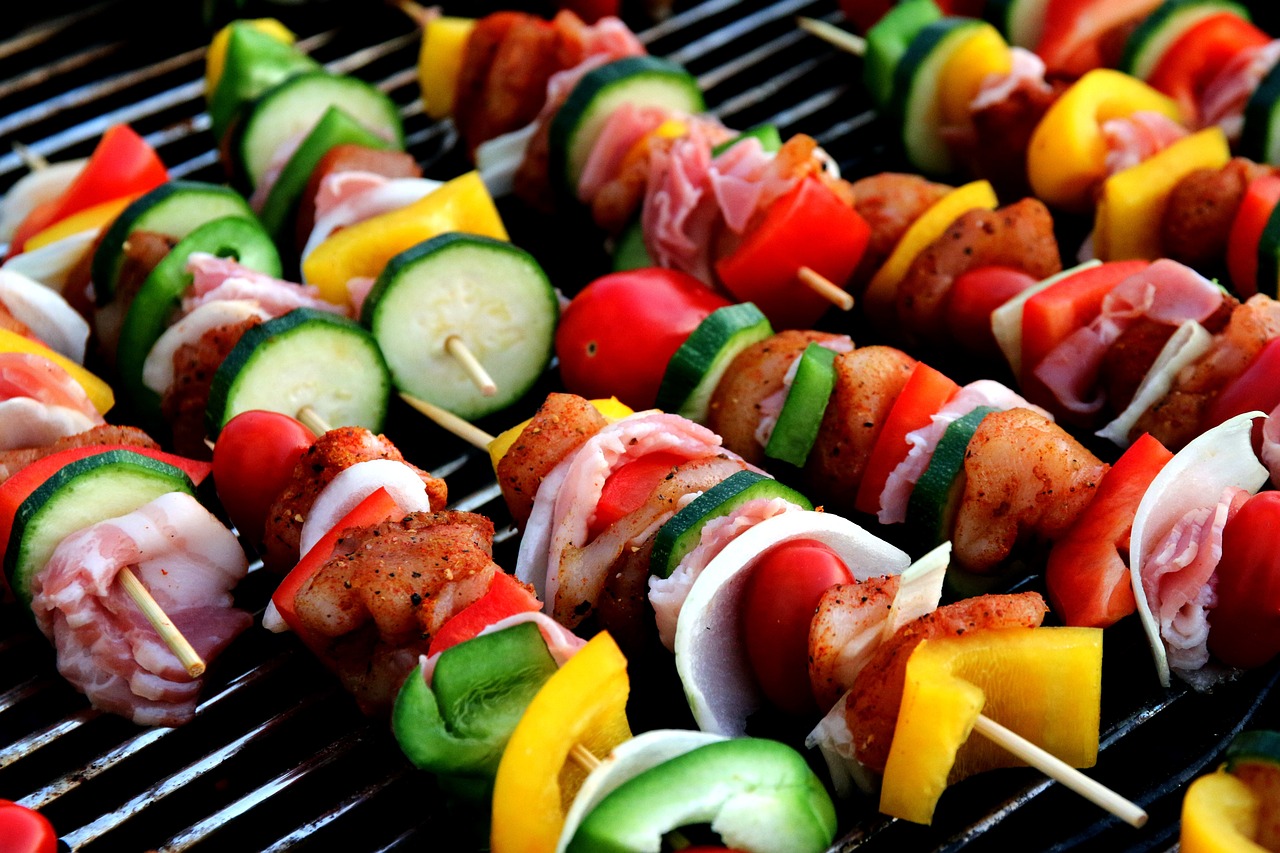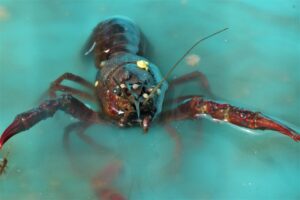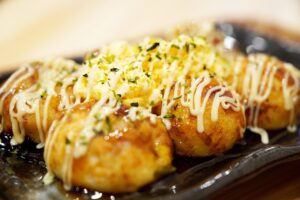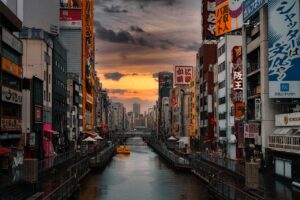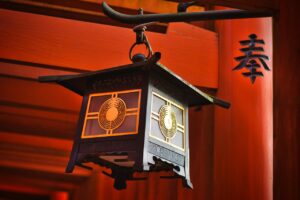Step out of the sleek, quiet efficiency of an Osaka subway car at Namba Station, and you are immediately reborn into a different world. The air itself changes, thickening with a palpable energy, a riot of sound and scent that pulls you forward. This is the gateway to Dotonbori, the glittering, beating heart of Osaka’s soul. It’s a place that doesn’t just welcome you; it consumes you. Giant mechanized crabs wave their claws, mythical dragons puff smoke from their nostrils, and a perpetually running athlete cheers you on from a colossal screen. This is a cityscape born from a fever dream of commerce and pleasure, a canal-lined corridor where every square inch screams for your attention. But beneath the dizzying spectacle of neon and larger-than-life mascots lies the true purpose of this district, a philosophy woven into the very fabric of Osaka itself: kuidaore. The glorious, unapologetic pursuit of eating until you drop. And in this grand theater of gastronomy, the undisputed star, the headliner of this culinary rock concert, is Wagyu beef. Here, Japan’s most revered culinary treasure sheds its formal, fine-dining persona and takes to the streets, sizzling on open grills, nestled in fluffy bread, and served on a single, perfect grain of rice. Dotonbori is where the legend of Wagyu becomes an interactive adventure, a personal quest for the ultimate bite, served under the watchful eyes of a thousand glowing lanterns. It’s a journey for the senses, a pilgrimage for the palate, and it all begins right here, in the electric heart of Japan’s kitchen.
To further explore the vibrant culinary scene that defines this area, discover the halal food options in Namba.
The Soul of Osaka’s Culinary Scene: Kuidaore and Dotonbori
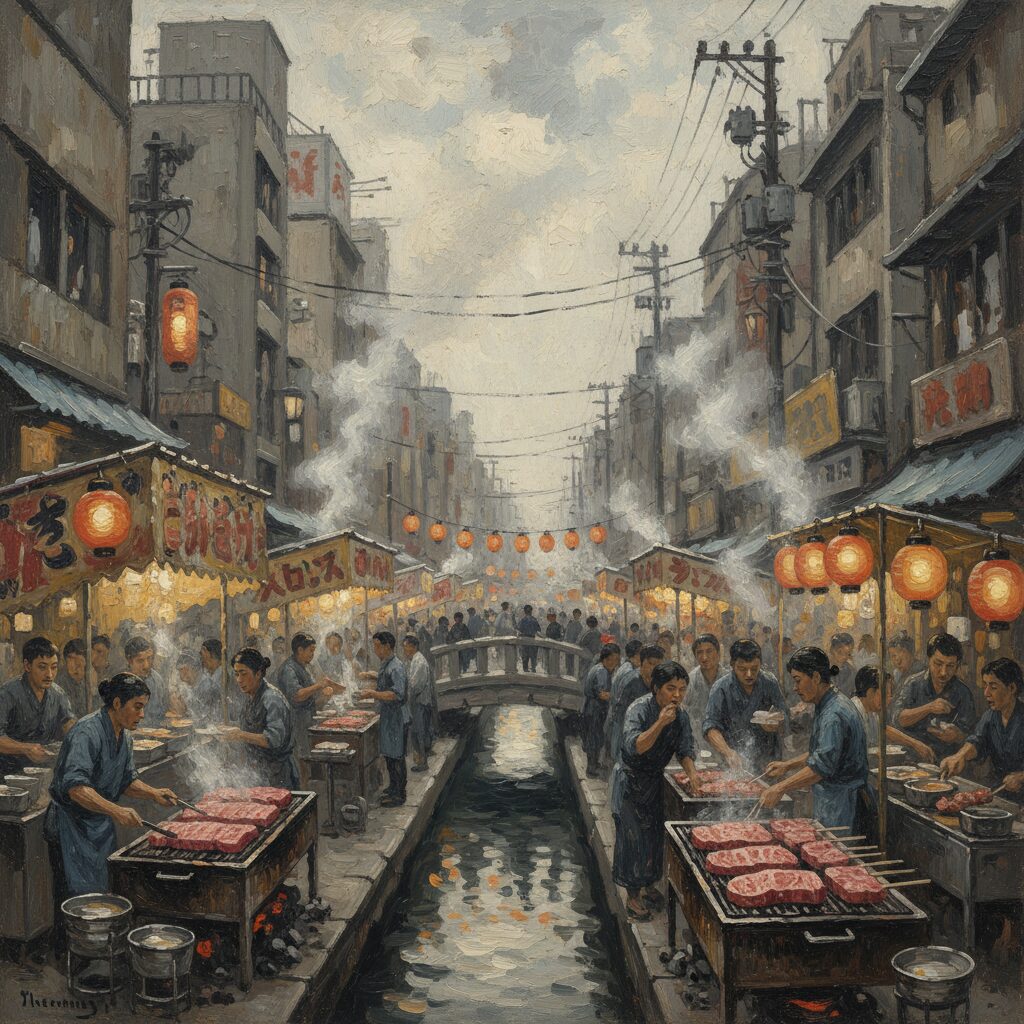
To truly appreciate the magnetic charm of Dotonbori, one must first understand the concept of kuidaore. This term resonates with the city’s history, reflecting its role as Japan’s commercial center. In the Edo period, Osaka was known as tenka no daidokoro, or the nation’s kitchen. Rice and various goods from across the country filled the city’s warehouses, generating great wealth for its merchant class. Unlike the stoic samurai of Edo (present-day Tokyo) or the elegant aristocrats of Kyoto, Osaka’s merchants directed their riches toward earthly pleasures, chief among them being food. Kuidaore became their motto—a playful yet determined declaration to spend extravagantly on food and drink, even to the point of financial ruin. Though slightly tongue-in-cheek, the phrase captures the city’s deep passion for excellent, flavorful food enjoyed enthusiastically and without pretense. This spirit is the very essence of Dotonbori. The entire district stands as a living tribute to this philosophy. It is not a place for quiet, reflective dining. Instead, it is a sensory explosion, a vibrant carnival of consumption where restaurants, stalls, and streets blend into one endless feast. The air is thick with the savory steam of dashi broth from takoyaki vendors, the sweet, caramelizing aroma of okonomiyaki sizzling on griddles, and most intoxicatingly, the rich, buttery scent of Wagyu fat melting over blazing flames. The sounds form a chaotic symphony: the rhythmic clatter of spatulas, the sizzle of oil, vendors energetically shouting “Irasshaimase!” (Welcome!), and the lively buzz of crowds from all corners of the world. This is the tangible embodiment of Osaka’s love for food—loud, bold, and utterly irresistible. Dotonbori invites you not just to eat, but to join in a centuries-old tradition of culinary delight.
What is Wagyu? Decoding Japan’s Prized Beef
Before you begin your Dotonbori adventure, it’s important to grasp what makes Wagyu truly special. The term itself, 和牛 (wagyū), may seem straightforward, simply meaning “Japanese cow.” However, behind this simple name lies a complex world of careful genetics, strict standards, and an almost artistic method of cattle raising that has produced what many regard as the finest beef worldwide. This is no ordinary beef; it represents the result of a long tradition of selective breeding and refinement. There are four officially recognized Wagyu breeds: the Japanese Black (Kuroge Washu), which makes up more than ninety percent of all Wagyu cattle and is the breed you will almost certainly encounter in Dotonbori; the Japanese Brown (Akage Washu); the Japanese Shorthorn (Nihon Tankaku Washu); and the Japanese Polled (Mukaku Washu). The magic of Wagyu, especially the Japanese Black, lies in its unique genetic tendency to develop intense intramuscular fat. This is the famous marbling, or sashi, seen as delicate, intricate webbing throughout the muscle. Unlike the hard, chewy fat often trimmed from a Western steak, this fat is rich in unsaturated fatty acids and has such a low melting point that it literally melts on your tongue, flooding your palate with profound umami and buttery tenderness. To guarantee quality, all genuine Wagyu is graded by the Japan Meat Grading Association through a highly detailed system. The grade commonly noted, such as the prized “A5,” is a composite score. The letter (A, B, or C) indicates the yield grade—how much high-quality meat can be obtained from the carcass, with ‘A’ being the best. The number (1 through 5) represents the crucial quality grade, itself based on four specific criteria. The most important of these is the Beef Marbling Standard (BMS), rated on a scale from 1 to 12. To earn a quality score of ‘5,’ the beef must have a BMS of 8 or higher. The other criteria include the Beef Color Standard (BCS), the firmness and texture of the meat, and the Beef Fat Standard (BFS), which evaluates the color and quality of the fat. An A5 grade, therefore, indicates a carcass yielding the highest quantity of prime meat that has achieved the top marks in marbling, color, texture, and fat quality. You may also come across regional brands like Kobe, Matsusaka, or Ōmi beef. It’s important to note that these are not separate breeds; all are specific strains of Tajima cattle (a lineage within the Japanese Black breed) raised in their respective prefectures under exceptionally strict, closely guarded protocols. Thus, while all Kobe beef is Wagyu, not all Wagyu is Kobe beef. In Dotonbori, you will find a variety of Wagyu, often high-grade Kuroge Washu, renowned for its ability to provide that transcendent, melt-in-your-mouth experience even when prepared quickly at street-side stalls.
The Dotonbori Wagyu Experience: From Luxury to Street-Side Sizzle

Traditionally, a Wagyu experience is a formal occasion. It might be a teppanyaki dinner with a skilled chef performing a graceful dance of knives and flames, searing flawless cubes of steak right before your eyes. Alternatively, it could be a multi-course kaiseki meal in a tranquil, private room, where a single exquisite Wagyu dish is presented like a work of art. While these experiences are extraordinary, they often come with a steep price and a formal setting. Dotonbori completely changes this narrative. It takes this emblem of ultimate luxury and puts it directly into the hands of the public, set amid a bustling, neon-lit street. This democratization of Wagyu is what makes the Dotonbori experience so distinctive and exciting. It removes the ceremony and centers on the pure, unadulterated enjoyment of the beef itself. No reservation or dress code is required; just bring your appetite and a spirit of adventure. The street food vendors in Dotonbori have expertly adapted Wagyu to their rapid-paced environment, crafting a variety of preparations that showcase the meat’s best qualities in just a few bites. It’s a culinary crawl, a progressive meal where each stall offers a unique take on this magnificent ingredient. You might enjoy a single skewer as a savory starter, a piece of torched sushi as a decadent middle course, or a hearty sandwich as a grand finale. This is Wagyu on your own terms, savored amid the vibrant chaos of Osaka’s premier entertainment district. It’s an experience both elevated and approachable, perfectly reflecting Osaka’s own character.
The Classic: Wagyu Kushiyaki (Beef Skewers)
The most straightforward and essential way to savor Wagyu in Dotonbori is through kushiyaki, or grilled skewers. As you stroll the streets, your nose will inevitably lead you to a stall featuring a small charcoal grill, a glass case displaying glistening cubes of marbled beef, and a chef fanning the flames. This is where your journey begins. The charm of Wagyu kushiyaki lies in its simplicity. There are no complex sauces or elaborate techniques to mask the meat’s natural qualities. It is a pure tribute to the beef’s inherent flavor and texture. The preparation is a kind of street-side theater. You point to the skewer that calls to you — perhaps a richly marbled ribeye (rōsu) cut or a leaner yet still incredibly tender sirloin piece. The chef picks it from the case and places it over glowing white-hot binchōtan charcoal. The sizzle is immediate and sharp. As the fat renders, it drips onto the coals, releasing fragrant, savory smoke that envelops the beef, infusing it with a primal, smoky essence. The chef expertly turns the skewer to ensure a perfect char on the outside, keeping the inside beautifully juicy and pink. Seasoning is minimal, as it should be. A few skillful shakes of high-quality sea salt and freshly cracked black pepper are all that’s necessary to enhance the beef’s natural umami. When the skewer is handed to you, hot from the grill, the experience is instant and visceral. The first bite is revelatory. The slightly crisp, charred exterior gives way to an interior astonishingly tender, practically melting in your mouth. The flavor is immense — a deep, beefy richness balanced by clean salinity and subtle smokiness from the charcoal. It’s a concentrated taste of luxury, a brief masterclass in what makes Wagyu the king of beef, all while standing on a crowded sidewalk with the neon lights of Dotonbori reflecting in your eyes.
A Modern Marvel: Aburi Wagyu Sushi
If kushiyaki is the primal, classic expression of Wagyu, then aburi Wagyu sushi represents its modern, sophisticated evolution. This dish perfectly exemplifies Japanese culinary innovation, merging two of the nation’s iconic foods: pristine sushi and premium beef. It embodies an intriguing paradox, a bite that is both hot and cold, cooked and raw, simple yet complex. You’ll find it at specialized stalls, often with a chef wielding a blowtorch like a painter’s brush. The construction is deceptively simple. A meticulously formed lozenge of warm, seasoned sushi rice (shari) serves as the foundation. Draped over it is a thin, generously marbled slice of raw, high-grade Wagyu. Already, it’s a thing of beauty: the deep ruby of the beef contrasting with the pristine white rice. But the magic comes next. The chef ignites the blowtorch, and a controlled flame licks across the beef’s surface. This is the aburi process. You watch as the intricate web of sashi melts and bubbles almost instantly. The beef sears and caramelizes in seconds, releasing an unbelievably rich, nutty, and savory aroma that is utterly intoxicating. The piece is then presented to you, often on a small dish or bamboo leaf, perhaps with a whisper of sweet soy glaze, a pinch of pink Himalayan salt, or a tiny dab of freshly grated wasabi. To eat it is to experience a symphony of sensations. You place the entire piece in your mouth. The first impression is warmth from the seared surface, followed immediately by the cool, soothing texture of the raw underside of the beef and rice. As you bite, the rendered fat, now a liquid essence of umami, floods your palate. The beef is so tender it requires almost no chewing. It melds perfectly with the slightly sweet, vinegared rice, creating a flavor balance that is rich but not heavy, savory yet clean. It is a fleeting moment of pure gastronomic bliss, an ephemeral masterpiece embodying the innovative spirit of modern Japanese cuisine.
The Ultimate Indulgence: The Wagyu Katsu Sando
There are snacks, there are meals, and then there is the Wagyu Katsu Sando. This is not merely a sandwich; it is an event. It stands as the pinnacle of street food indulgence, a culinary statement that has gained a cult following worldwide, and Dotonbori is one of the best places to experience its decadent glory. Finding a vendor who specializes in this creation is like discovering a hidden gem. The price is significantly higher than typical street food offerings, but what you pay for is an exercise in perfection. At the heart of the sando is the katsu itself. This isn’t ground meat; it’s a thick, noble cutlet of premium Wagyu — often tenderloin (hire) or even the legendary chateaubriand, the most prized part of the fillet. The cutlet is simply seasoned, then coated in a light dusting of flour, dipped in egg, and finally breaded with airy, jagged panko, Japanese breadcrumbs prized for their superior crunch. The beef is deep-fried with surgical precision to achieve a golden, shatteringly crisp crust while keeping the interior perfectly medium-rare, showcasing its vibrant pink color and extraordinary tenderness. Equally important is the bread. This is not ordinary loaf bread; it is shokupan, Japanese milk bread, celebrated for its cloud-like softness, slight sweetness, and irresistibly fluffy texture. The crusts are carefully trimmed, leaving only the pillowy white interior. Once cooked, the katsu is rested briefly before being coated in a special sauce — typically a complex, tangy-sweet tonkatsu-style sauce with fruit and spice notes designed to cut through the beef’s richness. The cutlet is then nestled between two slices of ethereal shokupan, gently pressed, and sliced cleanly in half to reveal the breathtaking cross-section of crispy crust, meltingly tender pink beef, and soft white bread. The first bite is an almost spiritual experience. You feel the gentle yield of the shokupan, hear the audible crunch of the panko crust, and then melt into the beef itself, which feels like biting into butter. The Wagyu’s rich, profound flavor is perfectly balanced by the zesty sauce. It’s a masterclass in texture and flavor contrast — a sandwich both comforting and astonishingly luxurious. It embodies kuidaore in a single, impeccably crafted package.
Navigating the Neon Jungle: Practical Tips for Your Wagyu Quest
Embarking on a Wagyu adventure in Dotonbori is thrilling, but a bit of preparation can make the experience even more enjoyable. The area is a maze of covered arcades, narrow side streets, and a main canal-side promenade, all bustling with people. Getting there is easy. Dotonbori is most conveniently reached from Namba Station, a major transport hub served by several subway lines (Midosuji, Sennichimae, and Yotsubashi) as well as private railways (Kintetsu and Hanshin). From any of the station’s many exits, it’s a short, clearly marked five-minute walk north into the heart of the action. You’ll know you’ve arrived when the buildings grow taller and the signs become bigger and brighter. The atmosphere of Dotonbori shifts dramatically throughout the day. Visiting in the late afternoon lets you see the area in daylight with slightly fewer crowds, allowing you to browse stalls leisurely and get your bearings. However, Dotonbori truly comes alive after sunset. When hundreds of neon signs and digital billboards light up, they cast a vibrant, futuristic glow over the canal and surrounding streets. This is prime time for a food crawl, as the atmosphere buzzes with energy and the crowd’s excitement is contagious. Be ready for crowds, especially on weekends and holidays, when navigating the main street can feel like swimming against the tide. Although Japan is increasingly credit card-friendly, many smaller street food stalls in Dotonbori still operate on cash only. It’s wise to carry a sufficient amount of yen to avoid disappointment when you spot the perfect skewer. Ordering is usually straightforward. Most vendors have picture menus or even life-like plastic food models (sampuru) on display, so you can simply point to your choice. A friendly smile and a simple “Kore kudasai” (“This one, please”) will go a long way. Once you have your food, you’ll notice few people eat while walking, as this is considered poor manners in Japan. Look for a small, designated standing area near the stall where you can enjoy your purchase. This also allows you to savor the flavors without being jostled by the crowd. Vendors almost always provide a small trash bin for skewers, wrappers, and containers, so please be sure to dispose of your waste properly before continuing your journey.
The Broader Cultural Tapestry: Wagyu in Japanese Cuisine
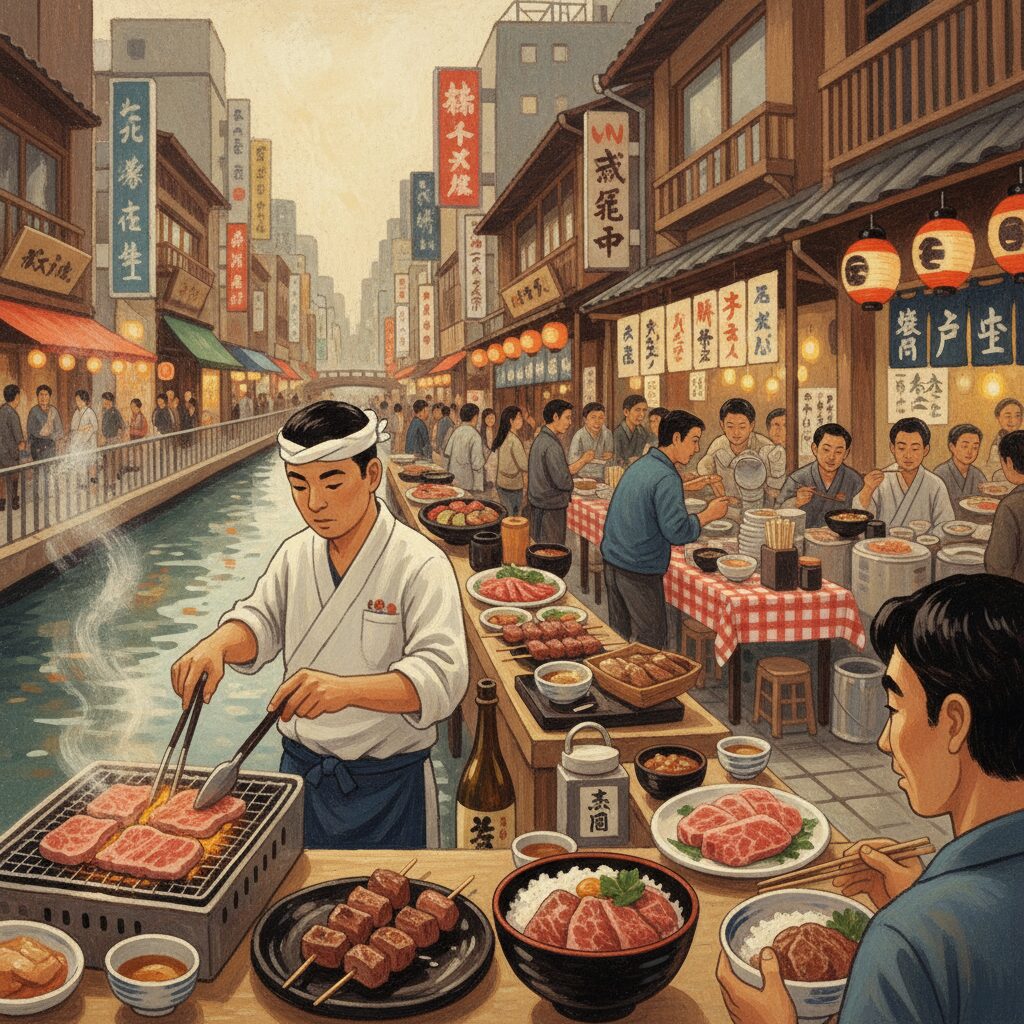
To truly appreciate the Wagyu you’ll enjoy in Dotonbori, it’s useful to understand its place within the broader context of Japanese culture and cuisine. For much of its history, Japan was predominantly a Buddhist country where eating meat from four-legged animals was either officially banned or socially frowned upon. It wasn’t until the Meiji Restoration in the late 19th century that these prohibitions were lifted, allowing a meat-eating culture to emerge. This history of scarcity and reverence influenced how beef was regarded: it was never considered a common staple but rather a precious, celebratory ingredient to be savored. This attitude nurtured a culture valuing quality over quantity, which directly contributed to the development of the careful breeding and raising methods behind Wagyu. The exceptional care given to the cattle—from their specialized diets to their low-stress environments—reflects the shokunin spirit, the Japanese ethos of craftsmanship and the relentless pursuit of perfection in one’s craft. This dedication goes beyond producing costly beef; it honors the ingredient and the entire process. Moreover, Wagyu perfectly embodies umami, the fifth taste. Discovered by Japanese scientist Dr. Kikunae Ikeda in 1908, umami is the deep, savory, and satisfying flavor found in foods such as kombu seaweed, mushrooms, and fermented products. The high levels of oleic acid and other beneficial fatty acids in Wagyu’s marbling create an intense, lingering umami sensation central to its appeal. When you savor that profound, mouth-watering richness, you are experiencing a fundamental principle of Japanese flavor science. Eating Wagyu in Dotonbori is therefore more than just enjoying a meal; it’s an encounter with centuries of history, culture, and culinary philosophy, all concentrated into a few perfect, unforgettable bites.
A Word on Price and Value: Is Dotonbori Wagyu Worth It?
As you browse the menus of the Wagyu stalls in Dotonbori, you’ll quickly notice that these offerings come at a premium compared to other local street food favorites like takoyaki or gyoza. A single Wagyu kushiyaki skewer might cost anywhere from 1,000 to 3,000 yen or more, depending on the cut and grade. A piece of aburi sushi could be priced between 500 and 1,000 yen, while a show-stopping Wagyu Katsu Sando can easily set you back 5,000 yen or more. Naturally, the question arises: is it really worth it? The answer lies in shifting the perspective from cost to value and experience. You’re not simply paying for a piece of meat; you’re paying for a taste of one of the world’s most coveted and carefully crafted ingredients. A full Wagyu steak dinner at an upscale restaurant in Tokyo or Kyoto might cost ten times as much, putting it beyond the reach of many travelers. Dotonbori’s street food scene cleverly breaks down this barrier, allowing you to sample this extraordinary beef and understand the hype without committing to an entire formal and much pricier meal. Think of it as a culinary tasting fee. For the price of a few skewers, you gain an education for your palate and a memorable experience. The real value lies in the accessibility and sheer joy of the moment. To make the most of your budget, consider a smart approach. Share larger, more expensive items like a Katsu Sando with a friend, enabling you to savor the best without spending your entire budget on one dish. Mix and match, balancing your Wagyu indulgences with more affordable Osaka classics. See it not as a cheap meal, but as an affordable luxury—a worthwhile investment in a truly unique and delicious cultural experience.
Your adventure in Dotonbori is a journey into the heart of Osaka’s identity. It’s a place that celebrates the joy of living through the pleasure of eating. The sizzle of Wagyu on the grill is the soundtrack of the district, its rich aroma the local scent. To stroll these streets is to engage in a dialogue with a culture that has perfected the art of indulgence. It’s more than just a food tour; it’s a vibrant, chaotic, and utterly delicious immersion into the spirit of kuidaore. So follow the smoke, trust your senses, and let the neon lights lead the way. Whether you opt for a simple skewer, a torched piece of sushi, or that legendary sandwich, you’re not just tasting beef—you’re tasting a piece of Osaka’s soul. Dive in, take a bite, and let the city’s electric energy and unparalleled flavors create a memory that will sizzle in your mind long after your last perfect bite.
